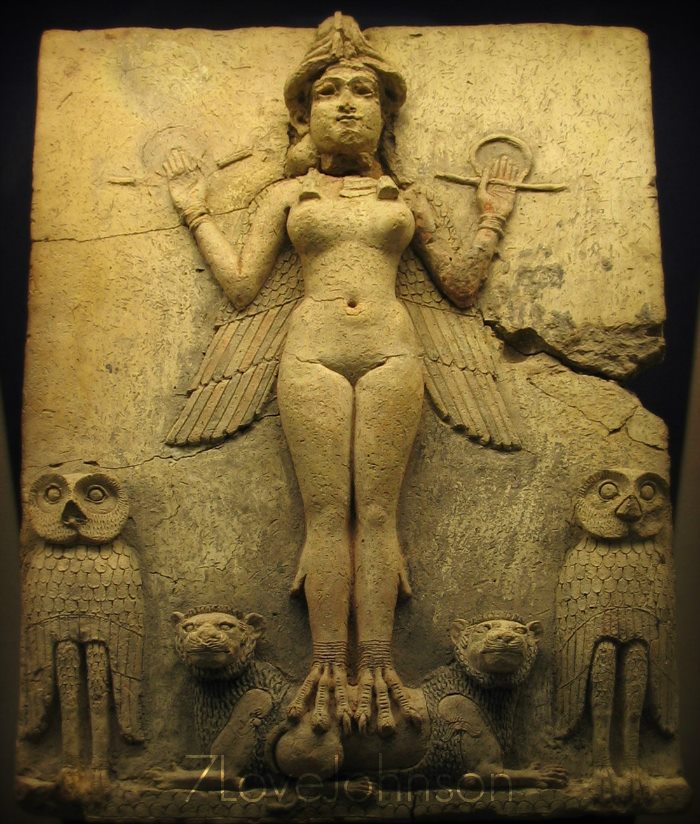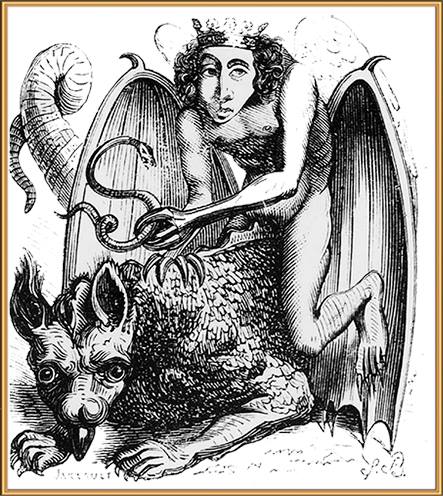 female: Astarte, or Ishtar, a goddess of the Middle-East roughly similar to Venus
female: Astarte, or Ishtar, a goddess of the Middle-East roughly similar to Venus
 male: Astaroth, as depicted in the Goetia
male: Astaroth, as depicted in the Goetia
This lecture will begin covering the grimoires and Goetic tradition, which is a curious anomaly in the history of magic. To adequately understand the Goetia, we must go back to the backdrop which the entities were first described and changed from gods to demons/djinn. The Goetia is just one text in the tradition of the Grimoires, all of which are highly, unapologetically syncretic and combines entities from almost half a dozen (known) pantheons, along with the techniques from another, much older magical source, the Greek Magical Papyrii.
The word Grimoire (grim-WOR) comes from French and means grammar. It is crucial to understand these books as laying down the syntax and semantics of a form of magic, rather than being the architectonic sources or final word on the matter. They are excellent manuals that can be used for constructing magic, but it is contentious whether any Grimoire “works” as-is. More on this topic later.
The word Goetia (go-EESH-a) comes from Greek goēteia and means “sorcery”. What is typically meant by “The Goetia” is a specific portion of the 17th century grimoire, The Lesser Key of Solomon. But it is a generic term that refers to a pre-modern magical practice of invoking entities, with the thin veneer of Judeo-Christian aesthetics. The entities in question can be referred to as imps or demons, but are properly understood as djinn due to their origination in the middle-east, mostly from Babylonian, Egyptian, and Canaanite pantheons.
Monolatrism or monolatry, also known as henotheism, is a type of polytheism. It recognizes the existence of many gods but with the consistent worship of only one deity — Zoroastrianism properly fits this title, but there is a compelling case one could make that the ancient Israelites were monolatric as well (having a patron god, among many, that favoured them, and told them to exterminate those who did not have a covenant with this god). But by the time the Old Testament was finished, and the apocrypha hidden, it was more or less monotheistic with several names of an adversary or adversaries in it.
It is important to compare the entities of the Canaanite and Babylonian religions to the religion of the ancient Israelites ( two of the major civilizations that the Israelites came into conflict with but also developed alongside of. Despite the Bible claiming the Israelites were in Egypt, there is no historical evidence of this). This is significant as there are salient discrepancies as well as evolutions that take place.
The Israelites originated as Bronze Age Canaanites, but their god, who eventually became known as YHVH, was not a Canaanite god. The head of the Canaanite pantheon was El, and one theory is that the name YHVH is a shortened form of el dū yahwī ṣaba’ôt, “El who creates the hosts”, referring to “the heavenly army accompanying El as he marched beside the earthly armies of Israel.” The divine figure in the Hebrew Old Testament’s Book of Genesis, Elohim, is a pluralization of El; El, also spelled Al (aleph lamed), is where the name Allah originates.
The gods of the Canaanites and Babylonians included Athtart (aka Ishtar, and, in Greek, Astarte), Ba’al (a title meaning Lord, compare to Hebrew Adon, and its plural form Adonai), Lotan (compare to Hebrew Leviathan), and many others. It is important to note that Canaanites refers to a specific group of people (and is the most referenced ethnicity in the Old Testament) — in contrast, the Philistines, another group the Israelites fought, is comparable to “barbarian” and basically means “outsiders.”
Of further note is that early Israelites emerged from the Canaanite religious traditions. The Canaanite gods are mentioned in the Hebrew Bible/Old Testament because the Jews had their own exclusive, patron god, with whom they made a covenant; but other gods existed. Over time, the books (the Bible, after all, was written over the span of thousands of years, not all at once by a single person such as Moses, who never happened to exist), leaned monotheistic. What happened is that the originally polytheistic Judaic religion became politicized as this tribe had to fight other Canaanite tribes. Eventually they formed a political egregore — the Lord YHVH; but the problem of other gods remained up in the air. At first, they were mentioned discretely — Baal being one example. But later down the line, these gods were demoted to lesser status. By re-explaining things in terms of fallen angels, or djinn, it becomes easier to explain away the idols of gods whose people you have conquered.
In the Ars Goetia, Athtart became Ashtorath (apparently undergoing a sex change); Ba’al became King Bael. Kusor wa hasis became Marbas. This come into the Goetic tradition directly. In the case of the Canaanite and Babylonian gods, it is probably the case that these entered the djinnic pantheon while the Old Testament was written, and treated as idols (“abominations”) or remained in folklore where they were perhaps given later treatment in the Qabalah; with other gods, it is more than likely they are later additions, which came into the Goetic tradition indirectly, via the Greeks, who did interact with the Egyptians: this includes Marquis Amon (there is an Egyptian god by this same name).
But there is, for whatever reason, no complete list of all 72 Goetic entities establishing a one-to-one correspondence with its original god or goddess source. Some are more than likely inventions of the people who compiled the Goetia, or were invented in the middle-ages, or are European in origin.
This lecture will continue next week, where we will look at where Satan fits into the Goetia.
